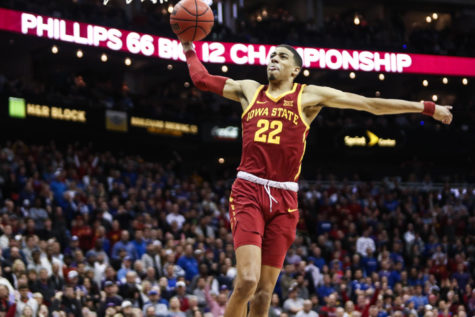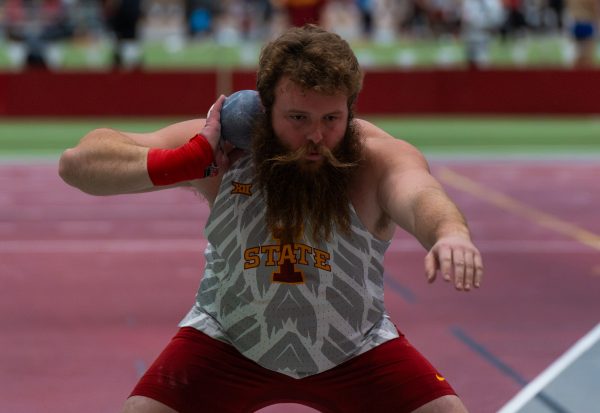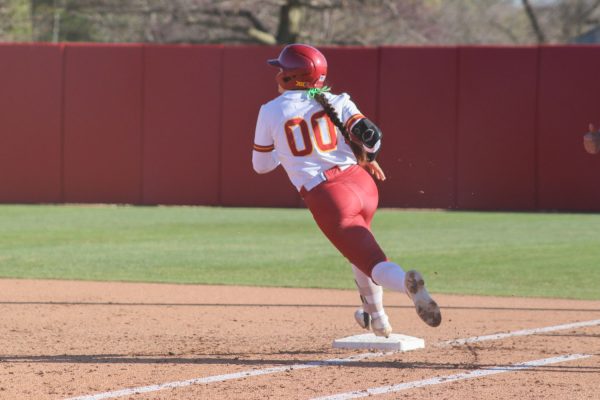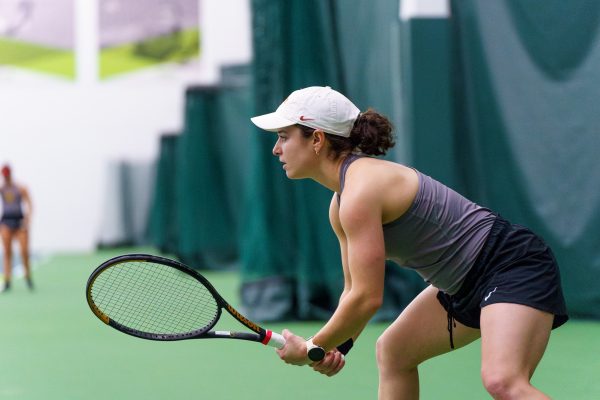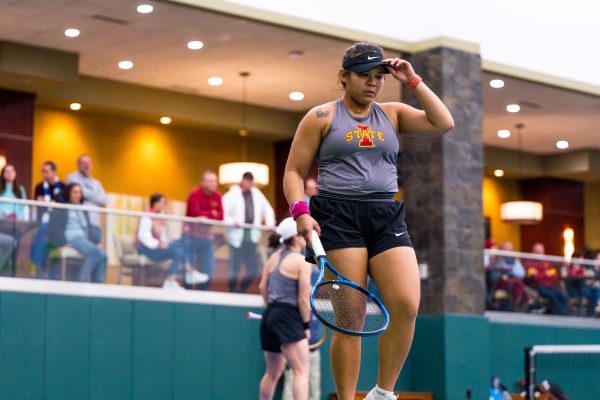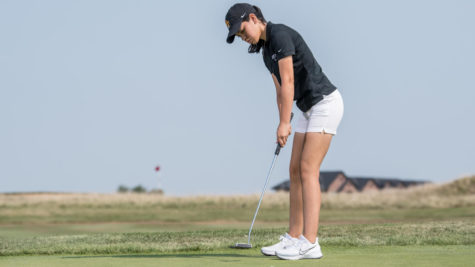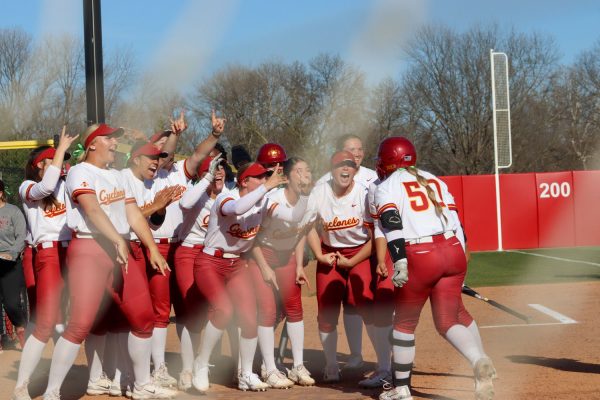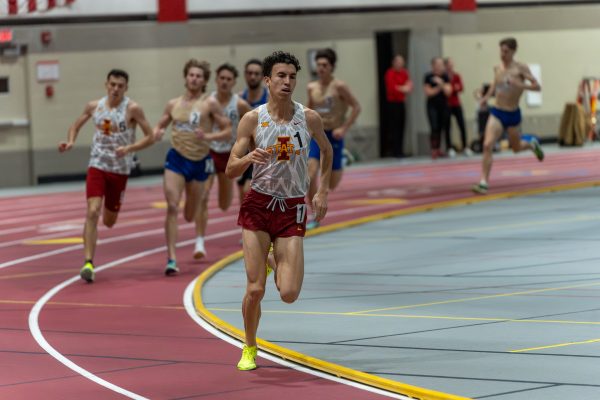For the love of the three
March 11, 2015
For seniors Dustin Hogue and Bryce Dejean-Jones, senior night was the last time the two would take the floor at Hilton Coliseum. But before the 21-point second-half comeback against Oklahoma, before the botched tip that proved to be the beginning of a slow start for the Cyclones, before Hogue and Dejean-Jones were honored with Daniel Edozie in the pregame festivities, there was another battle brewing.
As the team takes ‘shots in shoot-around, Hogue squares up for a shot two feet behind the 3-point line on the left wing. The ball bounces off the front of the rim as Dejean-Jones pulls up for an identical shot on the right wing, hitting nothing but nylon.
“Come on, man!” Hogue yells, throwing his hands up as Dejean-Jones flashes a rare smile.
The competition continues throughout warmups, with each of them glancing over at each other before each shot to make sure the other is watching. As the rest of the team files off the court, Hogue and Dejean-Jones are the last ones left shooting.
Standing closer to half court than the 3-point line, each take three, maybe four shots before jogging to the locker room. Both usually leave the floor with a grin because depending on who you ask, you will likely get a different answer as to who won.
“I think he’s won one game and I’ve won, like, 16,” Hogue said.
“I win all the time,” Dejean-Jones said.
While there may be no clear winner in the meaningless pregame shooting competition, the contest reflects the culture ISU coach Fred Hoiberg has established at Iowa State. For Hogue, it was a culture that was more intimidating than exciting.
Finding his shot
“I only made one 3-pointer in high school my whole four years,” Hogue said.
That statement is like nails on a chalkboard to college coaches across the country, especially for an undersized forward. In a high-octane, 3-point shooting system, Hogue’s hesitance on the perimeter seemed like anything but fitting.
In fact, his recruitment was a bit of an accident. At Indian Hills Community College in Ottumwa, Iowa, Hogue’s 3-point shooting had hardly improved. He made a total of 14 in two seasons. But he still caught the eye of the Iowa State coaching staff.
“When we went to recruit at Indian Hills, we were there to see Jameel [McKay],” Hoiberg said. “[Hogue] wasn’t a kid who shot many 3s in junior college, but to see the way he has evolved as a player… has been awesome.”
In just his first year at Iowa State, Hogue outpaced his previous 6-year total of 15 made 3-pointers, draining 22 from behind the arc while helping his team to the Sweet 16 in 2013-14.
The boost in production was also a boost in confidence, with Hogue jokingly calling himself the “best shooter in the country” after making his first 3-pointer of the 2014-15 season. While the 100 percent accuracy didn’t hold up, his 43.9 percentage from long range in the regular season led the Cyclones.
But the growth of Hogue’s 3-point shot is just one piece of Iowa State’s nationally recognized deep-shooting threat, and it started with a young Fred Hoiberg.
New coach, new mojo
Fred Hoiberg’s senior season as a Cyclone was one that solidified him as an Ames legend. His 89 3-pointers were a school record at the time, and his 183 career 3-pointers topped the history books as well.
His love for the 3-point line didn’t stop in college. He led the NBA with a 48.9 percent clip from behind the arc in 2004-05 with the Minnesota Timberwolves and infamously becoming the first player to lead the league in 3-point percentage without being invited to the 3-point shooting competition at the All-Star event.
So, it’s no surprise that one of the best 3-point shooters in ISU history favors the 3-point shot in his coaching career. In Hoiberg’s first four years of coaching, his teams made the 4th, 3rd, 1st and 2nd most 3-pointers in school history, respectively. This year’s team unsurprisingly sits in 5th all-time, making Hoiberg’s tenure the era of the 3-pointer at Iowa State.
In fact, the 3-point rate was so high that talking heads across the country refused to believe it would hold up game after game, season after season. The cliche, “live and die by the 3,” was a staple during television broadcasts of ISU games, as announcers doubted the longevity of the style.
But time and time again, Hoiberg proved his ability to develop sharpshooters as fifth-year transfers filed in with subpar 3-point averages and leaving with career-highs. The more his teams shot from long-range, the better they seemed to be, improving on a 16-16 record in Hoiberg’s first year, to three consecutive NCAA tournament berths topped off by a Sweet 16 run last season.
And again this year, Iowa State leads the Big 12 in 3-pointers per game despite having one of the nation’s most efficient interior offenses. For players and coaches, “live and die by the 3” was a concept that never existed.
“We’re going to live and die by each other,” Naz Long said. “It’s not about relying on the 3-pointers this year, it’s not about relying on the dunks or one guy, it’s about us playing together defensively and offensively, and we’re clicking right now at the perfect time.”
A different approach
ISU’s offense thrives off great spacing, constant ball movement and drawing defenders off of playmakers to get the open shot. The concept hasn’t changed under Hoiberg, but the rosters and number of shots has changed.
In 2012-13, it was all about volume shooting from outside. In fact, the team’s 924 attempted 3-pointers was a staggering 241 attempts more than any non-Hoiberg coached team in ISU history. Four players attempted 130 or more 3-pointers, including Tyrus McGee’s 96 makes on 207 attempts, leading the nation with a 46.4 percent 3-point clip.
In 2013-14, the volume stayed the same while the percentages dipped without McGee in the lineup. The team was making 8.4 threes per game, but at a pedestrian 35.8 percent rate, the “live and die by the 3” narrative was alive and well.
In 2014-15, the team may have found the perfect balance. The team has attempted a Hoiberg-era low of 646 3-pointers, but has shot an efficient 38.6 percent in Big 12 play with that number rising. But the reason for the more efficient perimeter shooting may be attributed to the man who hasn’t attempted a 3-pointer all season: Jameel McKay.
“We’ve got more depth on the inside now with Jameel McKay and Georges Niang being able to score down in the post a lot,” Hogue said. “When we have a game when we’re able to play inside and out, we get a lot of open threes.”
With all five players on the floor at least capable of shooting the 3-pointer in years past, McKay’s addition leaves opponents with one less player to worry about on the perimeter. However, it’s what he does inside that may actually help the team’s 3-point shooting.
McKay, along with Niang and Hogue, have helped the Cyclones dominate from inside this season, ranking in the top 10 nationally in 2-point shooting percentage. Drawing double and sometimes triple teams, McKay opens up the 3-point shooters Hoiberg has developed.
And make no mistake, this team has as many sharpshooters as ever. Hogue, Long and Niang each finished the regular season shooting 41 percent or better from behind the arc — easily the most to shoot that percentage in the Hoiberg era. And that’s not counting other players that have found their stride.
In the final seven games of the season, Monte Morris and Matt Thomas started heating up, hitting a combined 23-of-42 from distance. Bryce Dejean-Jones has proven to be a threat from behind the arc, most notably in a 4-for-4 performance against Arkansas.
And you can’t mention 3-pointers without Long. The sharp-shooter, famous for his clutch 3-point shooting against Oklahoma State and in the NCAA tournament had 71 3s in the regular season, sitting at 11th in school history and earning him a starting role on this year’s deep roster.
While this year’s team may not be setting school records or leading the NCAA in any 3-point category, Hoiberg and the Cyclones may have settled into the perfect perimeter balance heading into postseason play.
“When you’ve got four or five guys able to shoot the three and go to the post or finish at the rim, that makes it tough for teams to match up with us,” Hogue said. “We are one of the toughest teams to stop, and we use that to our advantage.”






